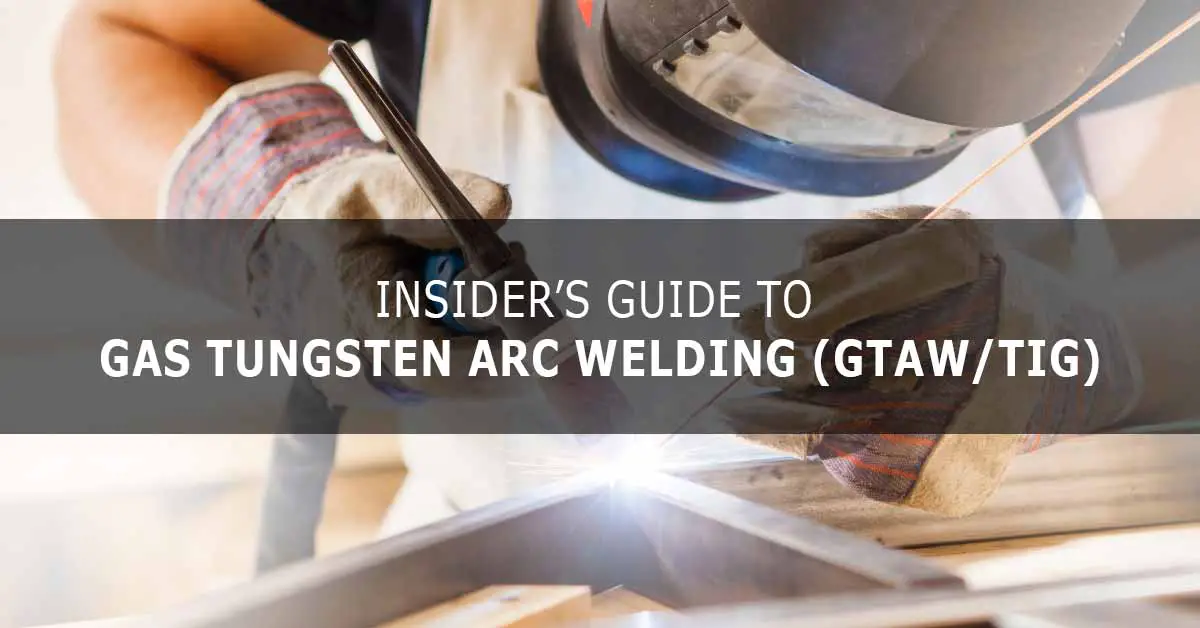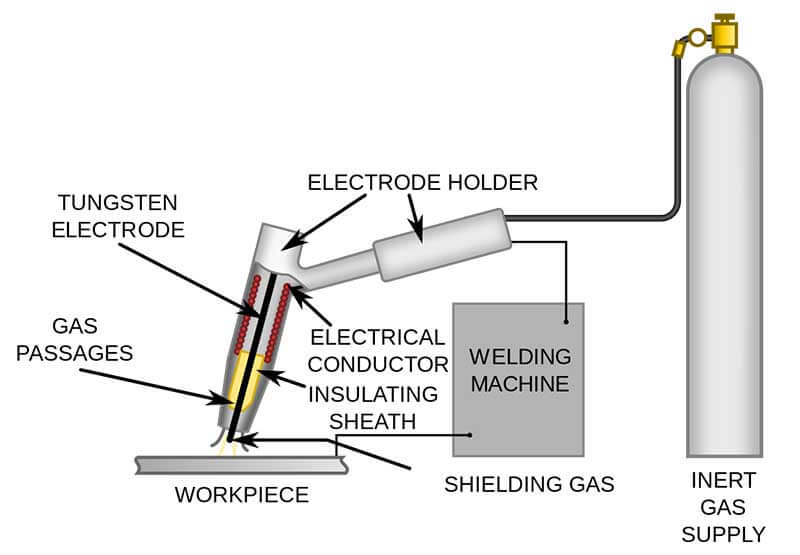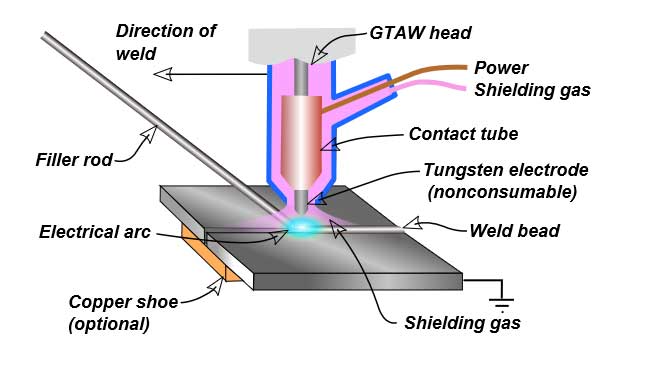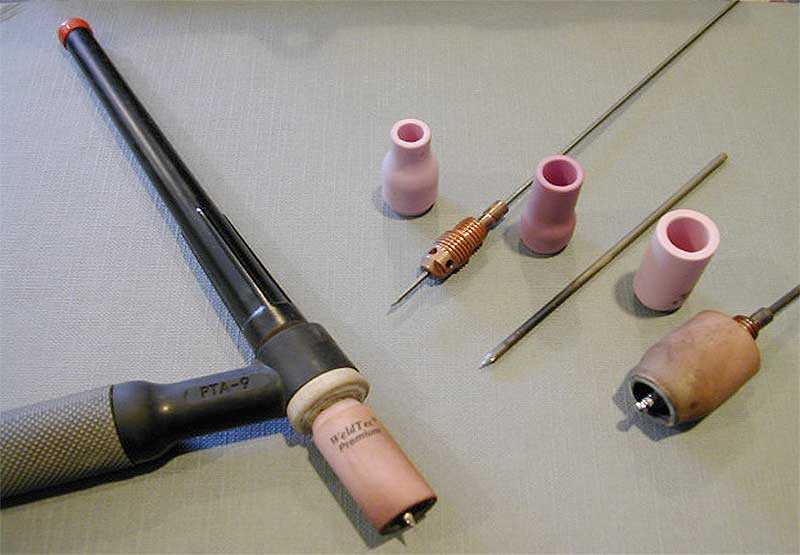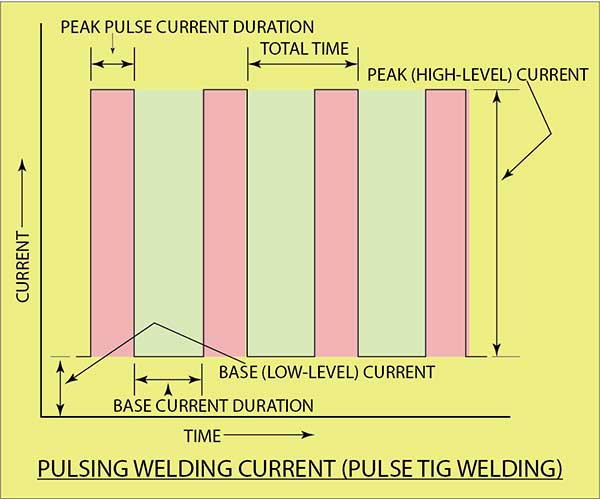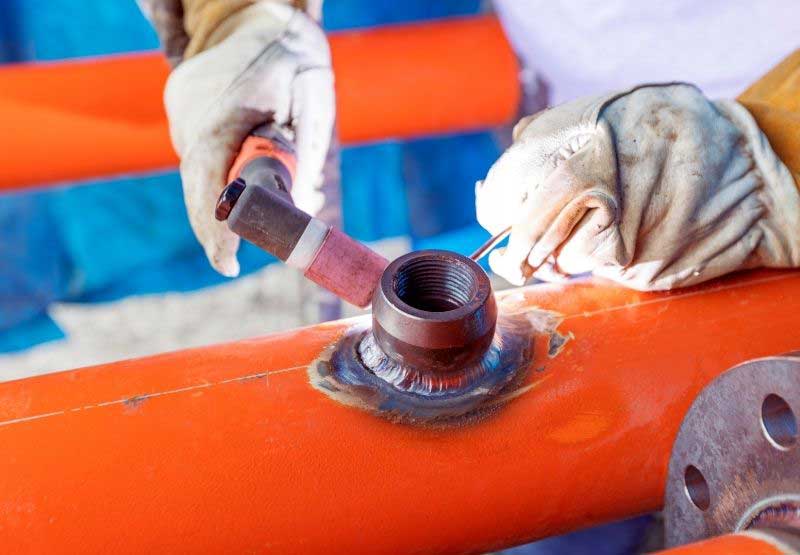TIG welding, also known as Gas Tungsten Arc Welding (GTAW), is a highly precise and versatile arc welding process that joins many metals, including aluminum, steel, and stainless steel. It is often used when aesthetics are important or when welding thin materials that can be easily distorted by other forms of welding.
This article will explore the basics of TIG welding, how it works, and its applications, and discuss the pros and cons of this type of welding. We will compare it to MIG welding and provide resources for beginning welders interested in pursuing a career in TIG welding.
What is TIG Welding (GTAW)?
Gas Tungsten Arc Welding (GTAW) or Tungsten Inert Gas (TIG) welding is a welding process that utilizes a non-consumable tungsten electrode to produce high-quality welds. The process involves using an inert shielding gas, usually argon, to protect the weld puddle from contamination.
GTAW or TIG welding is commonly used to join metals such as stainless steels, nickel alloys, copper alloys, and carbon steels. The process is known for its clean welds, precise control over the heat input, and the ability to weld thin materials.
The tungsten electrode is used only to maintain an arc, and a separate filler wire adds the metal to the weld pool. Typically, argon or helium, or a mixture of argon and helium, is used as the shielding gas.
TIG welding can work at low current; hence, the heat generated is low and low heat affected zone. This is an advantage when welding thin metal parts where the demand is to keep low heat.
Equipment Used in GTAW /TIG Welding
The success of TIG welding primarily depends on the use of proper equipment, including a welding torch, tungsten electrodes, inert shielding gas, welding machines, and filler rods or wires. We will now explore the different equipment used in this welding process and the role each plays in producing high-quality welds.
Power source
GTAW uses a constant current power supply to keep the current relatively constant, even when there is a variation in the arc length and voltage. This is an important aspect since most GTAW applications are either manual or semi-automatic, and in both cases, the TIG welder must operate the welding torch.
The polarity used (DCEN, DCEP, or AC) in Welding depends mainly on the metal to be welded. DCEN is regularly used for welding steels, nickel, titanium, etc. DCEN is also used for automatic TIG welding of aluminum or magnesium with helium as the shielding gas. DCEP is not common in TIG welding and is mainly used for shallow welds since the heat generated on the workpiece metal will be less. An alternating current (AC) is generally used for TIG welding aluminum and magnesium manually or in semi-automatic mode.
Welding Torch
GTAW torch has four main parts, non-consumable tungsten electrode, collet, gas nozzle, and torch cap. The torch is available in different types, shapes, and sizes, depending on the type of welding and the base material being welded.
The gas nozzle is one of the most critical components of the welding torch. It serves the purpose of directing the inert shielding gas flow to the weld pool, which protects the molten weld metal from atmospheric air and impurities. It is usually made of ceramic or other heat-resistant materials that can withstand high temperatures.
The collet is another significant part of the welding torch, which holds the tungsten electrode in place. Choosing the correct type and size of the collet is essential to ensure a secure and stable grip on the electrode, which ultimately affects the quality of the weld.
The torch cap is a protective cover that holds the nozzle in place and helps regulate the gas flow rate. It must be the appropriate size to fit the nozzle and create a snug fit to prevent gas leakage or loss of shielding protection.
TIG torches are available in two cooling options: water-cooled and air-cooled. Water-cooled TIG torches are ideal for high-duty cycle welding, while air-cooled TIG torches are suitable for low to medium-duty cycle welding applications.
Filler Metal/Wire/Rod Selection
One essential factor to consider when gas tungsten arc welding is selecting the appropriate filler metal or wire. The filler material is used to strengthen or join two pieces of metal during welding. It is essential to select a filler metal that is similar in composition to the material being welded to maintain the desired properties of the metal.
The selection of proper filler wire metal is essential for good welding. In many cases, the welding may produce cracks even when you select a filler metal of the same composition as the workpiece metal. Hence, it is prudent to select a filler metal after a thorough consideration of the following:
- Requirement of the mechanical properties.
- Metallurgical compatibility between the workpiece and filler metal.
- Tendency/history of cracking of the workpiece metal during welding.
Choosing the appropriate filler metal can be challenging since every metal has unique characteristics and requires a specific filler wire type. For instance, welding aluminum requires a different filler wire than welding stainless steel. Using the wrong filler wire can lead to weak welds or cause the metal to crack.
Inert Shielding Gas Selection
Selecting the appropriate inert shielding gas is critical to achieving high-quality welds. Inert gases protect the welding area from atmospheric contaminants, such as oxygen and nitrogen, which can cause weld defects. The choice of shielding gas can affect the weld characteristics, including penetration, heat requirements, and welding speed.
Common types of inert gases used for GTAW include argon, helium, and mixtures of the two. Argon is the most commonly used shielding gas because it is affordable, widely available, and provides good arc initiation and stability. Argon also produces a narrow, heat-affected zone, producing high-quality welds with excellent penetration. However, argon requires higher heat input, slowing the welding process.
Helium, on the other hand, requires lower heat input and can increase welding speed. Helium also produces a wider and deeper weld pool, resulting in greater penetration. However, helium can be more expensive than argon, and its use requires adjustments to the welding technique.
Argon and helium mixture can balance the two gases, allowing for good penetration and welding speed without requiring as much heat input as using pure helium. The most common mixture is 75% argon and 25% helium.
The choice of shielding gas depends on the base material being welded. Argon is suitable for welding most carbon steel, stainless steel, and aluminum materials. Helium is commonly used for welding non-ferrous metals such as copper alloys and nickel alloys. When welding high-alloy steels, a mixture of argon and helium is recommended.
Electrode Selection
Choosing the appropriate tungsten electrode is crucial to achieving high-quality welds in TIG welding. The electrode serves as the conductor that delivers the current to the welding arc, and its composition and color code impact the behavior of the weld pool.
The first consideration in selecting a tungsten electrode is its diameter. The diameter should be chosen based on the thickness of the material being welded and the welding current used.
The second consideration is the electrode material. Tungsten electrodes are available in various compositions, each with specific properties that make them better suited for certain applications. The most common types of tungsten electrodes are:
- Pure tungsten (green).
- 2% thoriated tungsten (red).
- 2% ceriated tungsten (gray).
- 5% lanthanated tungsten (gold).
- Rare earth tungsten (brown).
Related Article: Tungsten Electrode Sharpening Tips And Tricks.
Applications of TIG Welding
The following is some of the most common application of TIG Welding:
Various Industries: TIG welding is widely used in aerospace, chemical, and food processing machinery industries for its high-quality welding, specifically for thin workpieces of aluminum, stainless steel, and other metals. It is also a preferred process for the maintenance of tools and dies.
Root-pass Welding: TIG welding is often used for the root welding of thicker metals, and the subsequent welding passes can be continued with other welding processes. This is specifically useful for welding pipes.
Dissimilar Materials: TIG welding is used for welding dissimilar metals like carbon steel with stainless steel.
Corrosion Resistance Applications: TIG weldments have corrosion resistance and resistance to cracks. This makes GTAW a preferred process for nuclear engineering and operations like sealing spent fuel containers before burying them and parts used in nuclear engineering.
Thin sheets Welding: TIG welding has advantages over other welding processes for welding thin sheets. GTAW is preferred for welding thin sheets of stainless steel and non-ferrous metals (aluminum, copper alloys, etc.).
GTAW / TIG Welding Materials Range
Gas Tungsten Arc Welding is a popular choice for welding materials such as stainless steel, aluminum, copper alloys, and nickel alloys.
Stainless Steels
Stainless steels are widely used for their exceptional properties. They are commonly used in the electronics and aerospace industry for their strength and durability in extreme conditions without suffering from corrosion.
Stainless steels come in different grades and types based on their composition. The most common types of stainless steel used in GTAW are austenitic, ferritic, and martensitic stainless steel.
Nickel Alloys
When TIG welding with nickel alloys, selecting the appropriate filler metal and welding technique is essential to ensure high-quality welds that meet the application’s demands.
Different types of nickel alloys are commonly welded with GTAW, including Inconel, Monel, Hastelloy, and Nichrome.
However, TIG welding nickel alloys presents some challenges, including hot cracking and porosity. Hot cracking occurs when the weld metal solidifies too quickly and causes the metal to crack. To mitigate these challenges, proper welding techniques and processes must be used to avoid these issues.
Aluminum and other Non-Ferrous Metals
TIG Welding is a popular welding process used for non-ferrous metals such as aluminum, magnesium, and titanium.
Welding aluminum requires careful selection of the welding technique and filler metal due to its unique properties. For example, aluminum has a high thermal conductivity, requiring a higher heat input to achieve adequate weld penetration. Additionally, aluminum forms a thin oxide layer when exposed to air, which can contaminate the weld and disrupt the welding process.
Magnesium is highly flammable in its pure form and requires careful handling to prevent combustion during welding. A filler metal with a high content of aluminum or zinc is used to avoid the formation of pores in the weld.
Welding titanium presents several challenges, including high thermal conductivity and a low melting point. A filler metal with a lower melting point is used, and the welding process must be conducted in a high vacuum or protective gas environment to prevent contamination.
Advantages of TIG Welding
Here are some of the advantages of GTAW:
Stronger Welds: One of the significant benefits of TIG welding is that it produces strong and high-quality welds. TIG welding can create stronger welds than those produced by other welding techniques, such as MIG or Stick welding.
Wide Range of Materials: TIG welding is a popular process for welding stainless steels, nickel-based alloys, and non-ferrous metals such as aluminum, magnesium, and titanium.
Corrosion Resistance: TIG welding produces welds that have high corrosion resistance. The weld can retain strength and structure even in harsh environments, making it ideal for applications with corrosive substances.
Deeper Penetration: TIG welding can easily penetrate thick materials, such as stainless steel and aluminum. This allows for the creation and joining of thicker materials.
Versatile: TIG welding is versatile and offers several options to the welder. The TIG welder can perform welding with or without filler metals, depending on the requirements of the job. The welder can also control variables such as heat input, which can impact the quality and strength of the weld.
No Spatter: TIG welding does not produce a spatter, a common issue with other welding techniques. This eliminates the need for post-weld clean-up, saving time and reducing costs.
Thin Sheets: Due to the low current, TIG welding can weld thin metal sheets.
Limitations of TIG Welding
Though TIG welding has a lot of advantages, a few limitations are there to record, such as:
Skilled Welder: The GTAW process requires good coordination of eyes and hands, and the welder commonly uses both hands during welding. GTAW needs high skill, and the training period is much longer than other welding processes.
Low Deposition Rate: The rate of weld metal deposition or speed of welding is low compared to other welding processes making it more expensive compared to other welding types.
Pulse Type TIG Welding
Pulse TIG welding is a variant of GTAW/TIG welding, and in this process, the welding current pulses vary between a high and a low level. A high-level or peak current is used for melting, and the low-level or base current has two functions, sustaining the arc with low heat and enabling the weld pool’s solidification.
Pulse TIG welding enables the welding of thin metal sheets using very low heat. This overcomes the issues faced in conventional TIG welding, such as melt-through, distortion, tolerance, and heat-affected zone (HAZ). In pulse TIG welding, the weld bead comprises continuous overlapping weld spots if welding is done using low-frequency pulsing.
The advantage of pulse TIG welding is the better mechanical properties of the weld metal due to a fine grain structure (for both low and high frequencies).
Disadvantages of pulse TIG welding, very low pulse frequency leads to the formation of pores. Long base current duration causes fast solidification and insufficient opportunities for the gasses to escape from the weld pool.
Procedure for GTAW /TIG Welding
Here are the procedures for GTAW:
1. Preparing the Base Metal for Welding
Preparing the base metal for TIG welding is a crucial step that significantly impacts the quality of the final product. The following instructions will guide you through the process of preparing the base metal for TIG welding:
- Ensure a clean surface: The surface should be clean and free of contaminants like oil, grease, and rust.
- Align and clamp: It is essential to align the pieces correctly and clamp them together. This step will ensure that the pieces maintain position throughout the welding process.
- Smooth edges: Make sure the joint edges are smooth, with no gaps or burrs.
- Bevel edges: It is crucial to bevel them for certain applications.
- Clean the joint area: Finally, clean the joint area with acetone or a degreaser to remove any remaining oils or contaminants from the joint area.
2. Establishing The Desired Heat Input and Arc Length
Establishing the desired heat input and arc length is crucial for achieving high-quality welds and preventing damage to the base metal. Heat input refers to the amount of heat applied to the base metal during the welding process. Too much or too little heat can adversely affect the weld’s quality.
The welding current, welding speed, and arc length must be adjusted appropriately to determine the correct heat input. The welding current can be set based on the base metal thickness per the manufacturer’s recommendation. The welding speed also plays a vital role in regulating the heat input. The higher the welding speed, the lower the heat input, and vice versa.
Arc length, on the other hand, is the distance between the tungsten electrode and the workpiece during welding. A shorter arc length will produce a more concentrated and hotter arc, resulting in a shallow weld bead and less penetration. On the other hand, a longer arc length will produce a broader, cooler flame, resulting in a wider bead with deeper penetration.
3. Starting the Arc and Controlling the Puddle
To start the arc, the welder must establish a steady arc length, typically about 1/8 inch. The torch should be positioned at a 10~15-degree angle towards the weld joint, allowing the tungsten electrode to come as close to the workpiece without touching it.
Once the arc is established, the welder can slowly move the torch along the joint’s length. Staying ahead of the weld pool is crucial to avoid overheating the base metal or burning through it.
The filler metal should then be introduced slowly into the weld pool, making sure to avoid adding too much or too little. During welding, the welder must maintain a consistent pace and filler metal volume until the weld is complete. This will ensure that the weld bead is evenly distributed and the joint is strong and stable.
Career and Salaries in TIG Welding
TIG welding is a highly sought-after skill in the welding industry, and there are many opportunities for welders who specialize in this form of welding.
For those looking to pursue a career in TIG welding, various training programs are available to learn the basics and hone your skills. Furthermore, due to its precision and complexity, TIG welders typically earn higher salaries than other welders. With the right qualifications and experience, it can be an incredibly rewarding career path for those passionate about welding.
TIG welding is a highly skilled trade, and salaries reflect this. According to the U.S. Bureau of Labor Statistics, welders earned an average salary of $42,490 in 2019, with experienced professionals earning up to $74,590 annually. The top 10 percent of TIG welders also had an annual income of more than $96,100 that year. With certification and increasing experience in TIG welding, wages can increase significantly due to the specialized nature of this type of welding.
Salaries will also vary depending on location, industry, and certifications obtained by the welder or their employer. Companies usually pay a premium for TIG welders due to their mastery of GTAW techniques and precision in joining metals cleanly and accurately. Therefore, if you are considering a career as a welder, learning the art of TIG welding can offer higher potential salaries and job security over other types of welding.
TIG vs. MIG Welding: Comparing the Pros and Cons
Gas Tungsten Arc Welding is similar to MIG welding as both use an electric arc to join two metal pieces together, but there are some significant differences between the two.
The key difference between TIG and MIG welding lies in how they feed filler material into the weld. While MIG requires an external spool of wire, TIG relies on manually feeding a separate rod into the weld puddle. This gives TIG welders more control over their welds and allows them to add specific filler materials as desired.
TIG welding is used in various applications, including fabricating thin gauge aluminum and stainless steel. It is also often used in high-precision welding processes, such as aerospace work because its higher heat control capabilities allow for more precise welds. On the other hand, MIG welding is better suited to bigger projects that require large amounts of filler material quickly. As a result, MIG welding typically requires less skill than TIG welding and can be completed faster.
Overall, both TIG and MIG welding offer advantages and disadvantages depending on the project. TIG offers greater precision and control over the welding process but may require more skill from the welder, while MIG is faster but produces a welded joint that is not as precise, strong, or clean as a TIG joint.
FAQs About TIG Welding
What is TIG Welding?
TIG welding, also known as gas tungsten arc welding (GTAW), is a highly precise and versatile arc welding process that joins many metals, including aluminum, steel, and stainless steel. It is often used when aesthetics are important or when welding thin materials that can be easily distorted by other forms of welding.
How Does TIG Welding Work?
TIG welding creates an electric arc between the non-consumable tungsten electrode and the workpiece. The heat generated from this arc melts the electrode and metal, being welded together to form a strong joint. Argon gas is fed into the area surrounding the weld to protect it from oxidation and contamination.
What Are the Applications of TIG Welding?
TIG welding is commonly used in aerospace, automotive, architectural, and medical fabrication industries. It can also be applied to repair or fabrication work across various materials, including aluminum, magnesium alloys, stainless steel, copper, brass, and bronze.
What Are the Pros of TIG Welding?
The primary advantages of using TIG welding are its high precision (reducing rework), ability to create smoother welds with minimal heat input distortion (making it ideal for thin metals), better control over welding parameters compared to other processes, and cleaner finish results than traditional MIG welding.
What type of materials can be welded with TIG?
With the right electrodes and technique, you can use TIG welding to join various materials, including aluminum, steel, stainless steel, magnesium, nickel alloys, and titanium.
What is the difference between TIG and MIG welding?
The main difference between TIG and MIG welding is the type of arc used to create the weld. A non-consumable tungsten electrode in TIG welding produces an electric arc that creates heat when it comes in contact with the metal being welded.
While in MIG welding, a wire feeder supplies continuous filler material which melts and forms a joint. TIG welding is often used when welding thin materials that can be easily distorted by other forms of welding.
Conclusion
TIG welding is an incredibly precise and versatile method of welding that can be used for various applications. Experienced welders who master TIG welding will find many job opportunities available to them in various industries. Beginners can also learn the basics through online courses and tutorials.
By learning more about TIG welding, you will be able to make informed decisions when choosing the best method for your projects. We hope our article gave you good information on this special welding process.
References:

